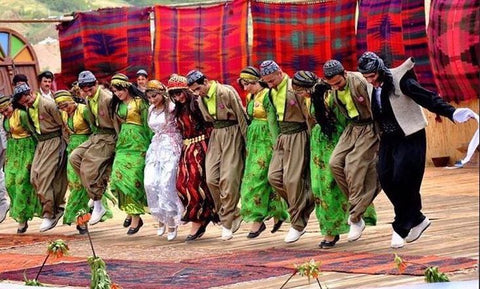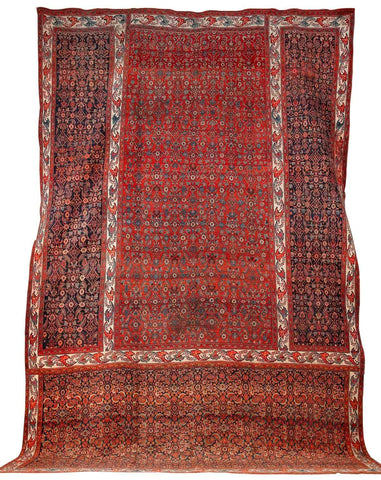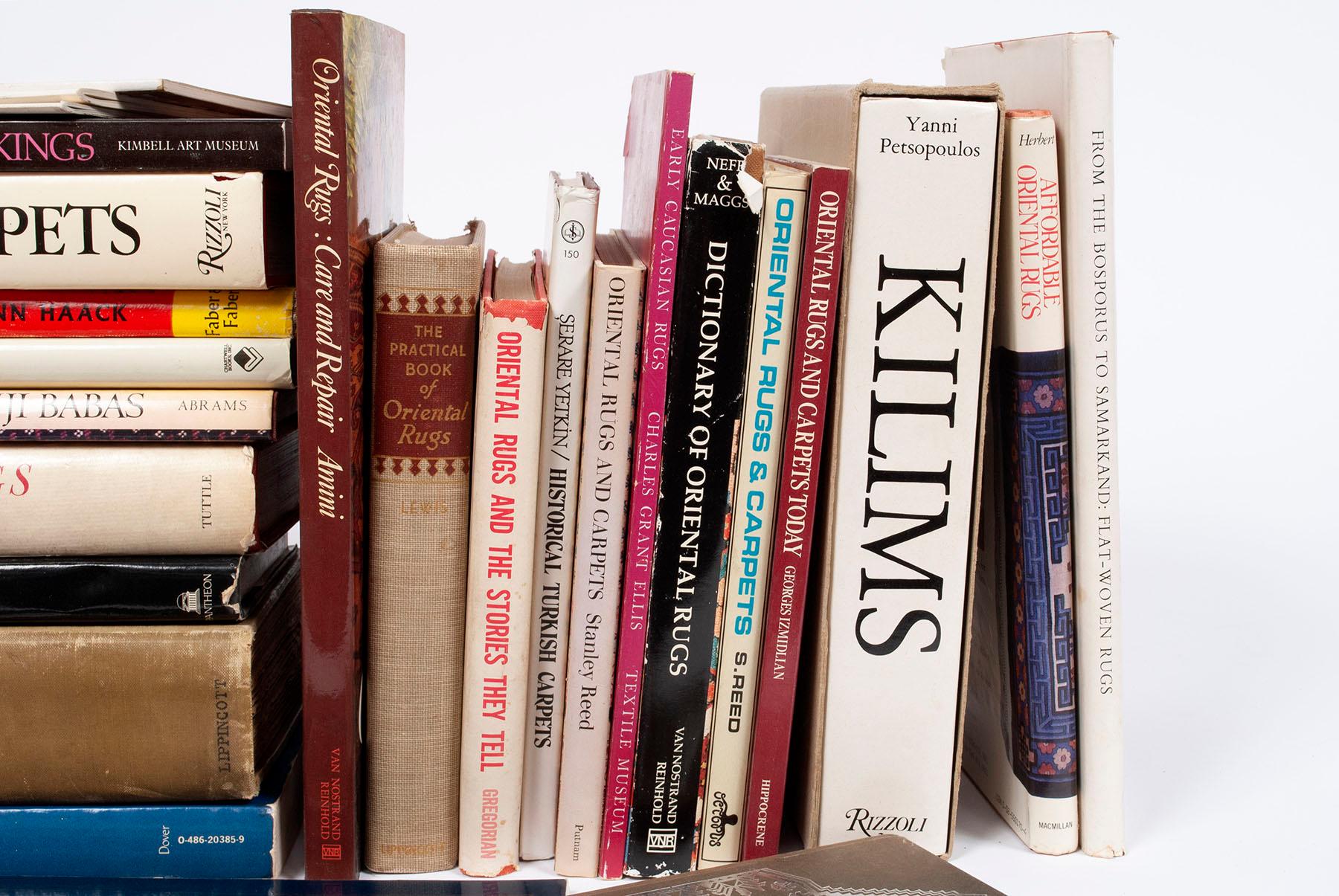Have you ever heard of Persian Bidjar rugs or bijar rugs? If not, you are missing out on one of the most exquisite and durable types of rugs in the world.
Persian Bidjar rugs, also known as bijar rugs, are hand-knotted wool rugs that originate from the Kurdish area of northwest Iran. They are also known as “Iron Rugs of Persia”, because they can last for centuries without losing their quality or appearance.
In this guide, you will learn more about the history, features, and value of Bidjar (Bijar) rugs. So, let’s get started!
History of Bidjar Rugs
Persian Bidjar rugs come from the Kurdish area of northwest Iran, also known as Iranian Kurdistan or Eastern Kurdistan. The name Bidjar comes from the capital city of the region, which is also the main production center of these rugs. The Kurdish people settled in the area and started weaving rugs as a part of their culture and tradition in the 16th century.
The Kurdish people are an ethnic group that inhabit parts of Iran, Iraq, Turkey, and Syria. They have a rich and diverse history, culture, and language, which are reflected in their rug weaving. The Kurdish people have been involved in many conflicts and struggles throughout history, which have influenced their rug designs and motifs. For example, some Bidjar rugs feature symbols of resistance, such as swords, shields, lions, or dragons.
The Bidjar rugs are also influenced by the neighboring Persian and Turkish cultures, which have had a long and complex relationship with the Kurdish people. The Bidjar rugs incorporate elements from both Persian and Turkish rug styles, such as medallions, borders, colors, and patterns. However, the Bidjar rugs also have their own distinctive features and characteristics, such as their unique weaving technique and their high quality and durability.
Since the 19th century, Persian Bidjar rugs have been exported to various parts of the world, where they became popular among European and American collectors and connoisseurs. Many museums and galleries, such as the Metropolitan Museum of Art in New York, the Victoria and Albert Museum in London, or the Textile Museum in Washington D.C., have also exhibited these rugs. They are considered to be among the finest and most valuable types of Persian rugs in the world.

Dance: A unique signature of Kurdish identity
Weaving Technique
One of the most distinctive features of Persian Bidjar rugs is their unique weaving method, which is also known as “wet weaving”. This technique involves compressing the weft strands tightly between rows of knots, resulting in a dense and heavyweight rug. The weft strands are the horizontal threads that are interlaced with the vertical warp threads to form the foundation of the rug. The knots are the loops of wool that are tied around the warp threads to create the pile or surface of the rug.
The wet weaving technique requires dampening the wool as it is woven and then beating it down with an iron tool. The damp wool shrinks as it dries, making the rug very compact and strong. The iron tool, which is a heavy metal comb or hammer, is used to push down the weft strands and the knots, making them more tightly packed and aligned. This process also enhances the clarity and definition of the patterns and colors of the rug.
The wet weaving technique makes Persian Bidjar rugs very durable and resilient, and able to withstand up to 200 years of heavy use. Persian Bidjar rugs are also resistant to insects, moisture, and fire, thanks to their dense and tight weave. However, this technique also makes Persian Bidjar rugs very stiff and rigid, and difficult to fold or roll. Therefore, Persian Bidjar rugs are usually displayed flat on the floor or on a wall.

Bidjar Triclinium carpet. Iranian Kurdistan, 20 ft 11 in x 13 ft 2 in / Bonhams
Colors
Another feature that makes Persian Bidjar rugs stand out is their intricate and colorful patterns, which often feature geometric, floral, or animal motifs. The patterns are meticulously woven using a diverse palette of colors, with shades of red, blue, and ivory featuring prominently. The colors are obtained from natural sources, such as plants, minerals, insects, and shells, ensuring that they remain vibrant and long-lasting. Some of the natural dyes used for Persian Bidjar rugs are:
- Red: Red is the most dominant and symbolic color in Persian Bidjar rugs. It represents beauty, joy, courage, and life. Red is derived from various sources, such as madder root, cochineal insect, lac insect, or alkanet root.
- Blue: Blue is the second most common color in Persian Bidjar rugs. It represents spirituality, tranquility, wisdom, and royalty. Blue is derived from various sources, such as indigo plant, woad plant, or lapis lazuli stone.
- Ivory: Ivory is the third most common color in Persian Bidjar rugs. It represents purity, elegance, harmony, and light. Ivory is derived from various sources, such as wool itself, alum, or lime.
Other colors that can be found in Persian Bidjar rugs are green, yellow, orange, brown, black, and purple. Each color has its own meaning and source of origin.

Herati Bijar / Harvard Art Museums
Patterns
Some of the most popular patterns that can be found in Persian Bidjar rugs are:
Herati Pattern:
A central diamond-shaped medallion surrounded by floral motifs and four leaves characterizes the Herati pattern, which is a classic design. It is also called the “fish pattern”, because the leaves resemble fish tails. This pattern symbolizes water and fertility.
Boteh Pattern:
The Boteh pattern is a stylized representation of a leaf or a pine cone. It is one of the most universal designs in Persian rugs, and can be found in various sizes and orientations. The Boteh pattern is also associated with the Zoroastrian symbol of life and eternity. The Boteh pattern symbolizes fire and renewal.
Tree Pattern:
A tree of life, which represents the connection between heaven and earth, is the symbolic depiction of the Tree pattern. It can be either realistic or abstract, and it can include various animals and birds on its branches. This pattern symbolizes earth and creation.
Vase Pattern:
Featuring one or more vases filled with flowers, the Vase pattern is a decorative design. It can be either symmetrical or asymmetrical, and it can occupy the center or the corners of the rug. This pattern symbolizes air and abundance.
Garrus Design:
Garrus design is a type of Persian Bidjar rug that has a distinctive pattern of medallions, flowers, vines, and birds. It is named after the town of Garrus, where it originated. Garrus design rugs are very rare and valuable, as they represent the fusion of Kurdish and Persian cultures.

Mahi or Herati Bijar / Rug the Rock Collection
Quality and Value
The quality and value of Persian Bidjar rugs depend on several factors, such as:
- Material: Persian Bidjar rugs are made of high-quality wool, which is soft, strong, and lustrous. The wool is obtained from local sheep, which are raised in the mountainous regions of Kurdistan. The wool is hand-spun, hand-dyed, and hand-woven by skilled artisans, who use traditional methods and tools.
- Knots: Persian Bidjar rugs have a high knot density, which means that they have more knots per square inch than other types of rugs. The knot density determines the fineness and clarity of the patterns and colors of the rug. The higher the knot density, the higher the quality and value of the rug. Persian Bidjar rugs can have up to 500 knots per square inch, which is considered very high for hand-knotted rugs.
- Age: Persian Bidjar rugs are known for their longevity and durability, which make them more valuable over time. Older rugs are more rare and desirable than newer rugs, as they reflect the history and heritage of the Kurdish people. Older rugs also have more character and charm, as they show signs of wear and tear that add to their beauty. Some Persian Bidjar rugs date back to the 19th century or earlier, and are considered antique or vintage.
- Rarity: Persian Bidjar rugs are also valued for their rarity and uniqueness, as they are not mass-produced or widely available. Each rug is a one-of-a-kind masterpiece, that reflects the individual style and skill of the weaver. Some Persian Bidjar rugs have special features or designs that make them more rare and valuable.
Persian Bidjar rugs are among the most prestigious and valuable types of rugs in the world. They are admired for their quality and beauty, as well as their cultural and historical significance. They are not only functional items, but also works of art that can enrich any space. Hope you enjoyed reading this article.
Explore our carefully curated collection of Persian Bidjar Rugs that are available for sale.



















1 comment
Thank you for this concise review of Bidjar rugs and cluture. I am a very minor collector, and wish that I could travel freely to see these historical and cultural places. Instead, This ordinary man thanks you.
DD
Leave a comment